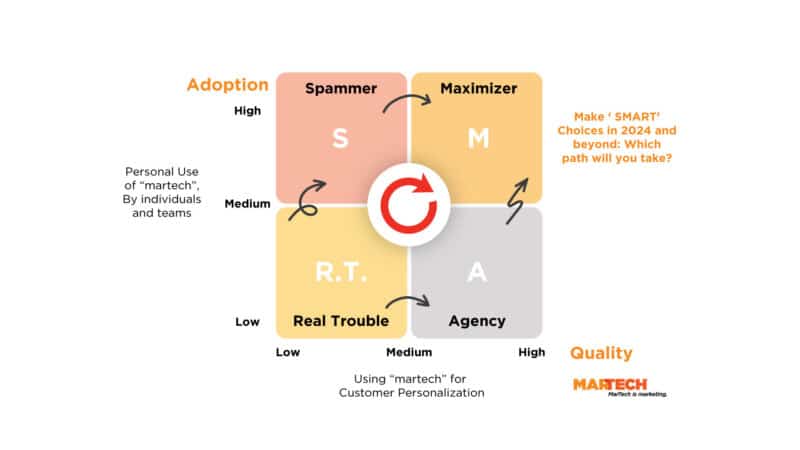Much of the marketing we create as marketers and experience as consumers is broad. Some of it will resonate with us; some it won’t. It’s always been this way because running truly 1:1 campaigns at scale simply isn’t possible today for most organizations.
In my March article, I unveiled a call to action to drive more truly personalized customer experiences. This included a framework that I am re-sharing below.

In this article, I will be focusing on the upper left quadrant of this framework, which I labeled as “Spammer.”
What I mean by ‘Spammers’
Spammers, in this context, are scaling their content practices around volume. I’m applying the term “spam” here because it’s become commonplace to refer to low-quality content as spam, regardless of whether or not it’s delivered via email. The introduction of generative AI is making this broad definition of spam even more common. (I also recently discovered a new term that could define all of this: slop.)
Whether you call low-quality content spam or slop, for our purposes in this article we’re focusing on better personalization of the permission-based emails sent to prospects and customers, as opposed to the unsolicited emails, which clearly remain a problem, as evidenced by the recent crackdown on bulk sending.
As digital leaders, we’re often helping others navigate the various labels and tactics used in marketing today. We’re still dealing with myths about email marketing — first and foremost the issue of its premature death as a valuable tactic.
Email marketing expert Jay Schwedelson continues to be a voice of reason on the topic, and not surprisingly, he continues to emphasize that ‘basic’ personalization does not move the needle anymore :
“Many marketers believe personalization just means including someone’s first name in an email or subject line. Like, “Hey Tom, check this out!” But that basic tactic no longer moves the needle. Real personalization means quickly conveying relevancy—why this message matters specifically to your target audience.”
Jay Schwedelson
Not only was email never dead, but all trends point to a renewed surge. Many teams are renewing their email investment in order to avoid the algorithmic biases of SEO and social, but most importantly they value the ability to communicate directly with their audiences. The emergence of Substack, beehiiv, Convertkit and others combine the new school of “creators” with old-school tactics like email newsletters.
We’re also seeing previously email-only systems like Mailchimp grow by increasing their capabilities with full customer profiles, functionality we typically associate with full-scale CRM.
Mailchimp’s CMO described the value of hypersegmentation, which require customer profiles.
“Hypersegmentation can enable marketers to reach the right customer with the right message at the right time. When customers receive more relevant and personalized emails, it drives loyalty and conversion.”
Michelle Taite, CMO, Intuit Mailchimp
Dig deeper: Salesforce’s AI CEO explains why this new AI wave is different
Can ‘hyper’ ever become a segment of one?
One pathway toward this outcome is examining how to improve the 1:1 email sequences that are the standard for enabling SDRs and BDRs — particularly in B2B campaigns.
As marketing teams align themselves further with sales and customer success teams, they are increasingly asked to support the content and delivery of email in 1:1 template-based campaigns, often under the banner of account-based marketing (ABM) and orchestration. More tactically, these sequences typically leverage approved marketing emails, but are sent on a 1:1 level by an SDR or BDR.
But we often treat this outreach like we treat mass campaigns. We hit the easy button and say it’s personalized using the recipient’s first name, “personalized” calls to action or simply claiming it’s better because it was sent from one person to another person or because they are receiving personalized journey email No. 2, which is sent after journey email No. 1.
If we’re being truthful, we know the majority of these messages are still based on broad behavioral cohorts, not on a truly personalized level that includes account preferences and the interests of the individual person.
Dig deeper: How Georgia-Pacific seeks to leverage AI to its full marketing potential
How AI will improve our personalization
For a peek at what’s already changing, let’s examine HubSpot’s update (in beta) for AI-infused email templates for sales. My eyes zoomed in — not on the AI content prompts that are now becoming commonplace — but the second area: customer analysis.
Although we’re all still learning how these capabilities work, I’m optimistic that the major martech platforms are factoring customer context into these communications workflows.
This is about more than the efficiency benefits of AI we hear about so often. I think this provides a pathway to put the person back in personalization.
Customer context
For further inspiration, I recently listened (twice) to the “Marketing Against the Grain” podcast (episode 233) from Kieran Flanagan and Kipp Bodnar.
I recommend tuning into the segment (around 17:30) when Kieran (former CMO at Zapier, who recently returned to HubSpot) covers a framework for how AI will enable teams to gather external information (LinkedIn, web content, etc.) and combine it with a company’s internal information about a customer (prior purchases, emails, customer service, etc.).
As they explained, AI will lower the barriers that previously prevented this from occurring at scale. AI can remove these barriers because:
- AI delivers the ability to scale personalized research. A whole series of martech scraping tools do this for us today.
- AI has the ability to make sense of unstructured data like emails, transcripts, discussions and more. Large language Models (LLMs) can synthesize all of this unstructured data.
The final factor Kieran and Kipp discussed was the human cost. As AI begins to reduce the human costs of scaling and synthesizing data, we will enter the next choice of what we do with the time we gain back.
If sales reps are now saving time because an AI assistant or agent does the research, the rep can spend more time on true human-led personalization, like factoring in the prospect or customer’s prior experience or perspectives and understanding customer needs, thereby tailoring the content they send.
Dig deeper: The data analytics hierarchy: Where generative AI fits in
What becomes possible when we enable ‘Customer Tone’
Imagine if the current HubSpot settings included an additional, hypothetical setting, which I added in the image below, called Customer Tone.
Imagine if the default setting for the emails and communications were based on a predictive “customer tone” model (instead of generalized versions like professional, helpful, witty, etc.), and you had settings in your CRM and MAP to gauge whether there is enough data (and of sufficient quality) for individual contacts to enable preferred tone.
I believe this impact will eventually be further extended to marketing-led “mass” campaigns. When all of the interaction is being tracked, it can subsequently be used to train and reinforce AI models.
Hyper-based optimism
Finally, I acknowledge that many of us are potentially suffering from AI hype fatigue. However, with the capabilities I’m seeing on the horizon, I think the latest improvements will, at the very least, force one critical decision this year. We can choose to get on the pathway toward better personalization by asking ourselves:
- Will we start on a roadmap to train models to reflect customer context and tone?
- Will we take the incremental human cost that we’re going to save through AI and use it to give humans the time to truly personalize communications?
Personally, I’m optimistic that many of us will choose that the ROI of personalization outweighs the scaling of just more volume, and start working toward this.
Email:
See terms.
The post When AI truly understands our customer data, we’ll deliver on true personalization appeared first on MarTech.






